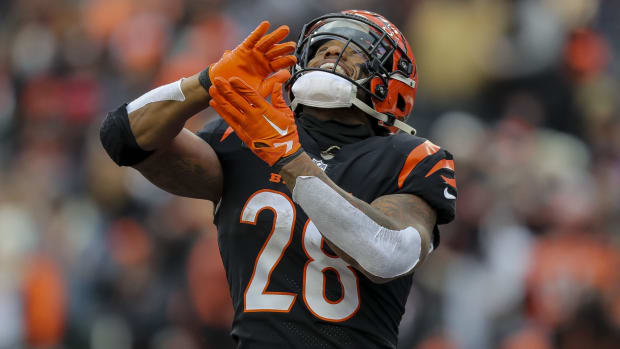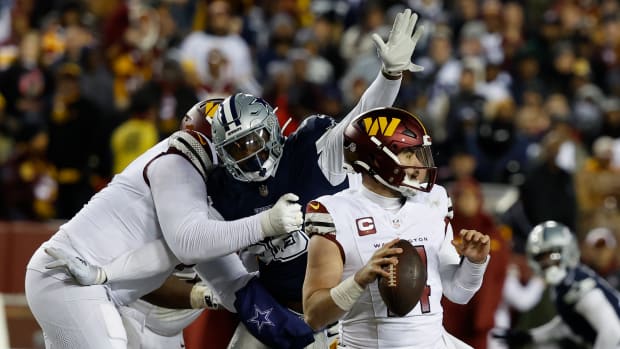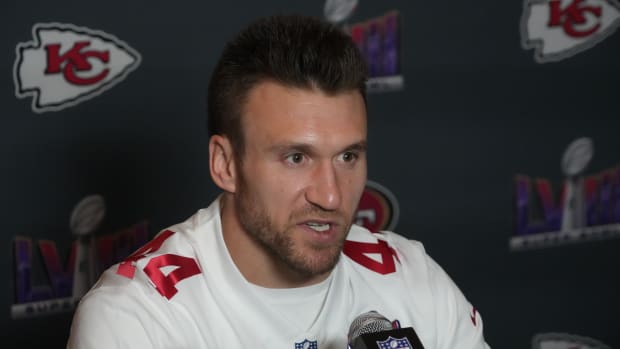
In Addressing Domestic Violence, the NFL Takes Its First Tangible Steps
NEW YORK — Dwight Hollier, the former linebacker who works as the NFL’s director of transition and clinical services, had thought of ways to relate to his audience. Standing in the Huddle Café at league headquarters on Monday night, he paused on a PowerPoint slide titled, “What is Physical Abuse to a Child?”
He told the room that his own parents sometimes used corporal punishment, a normal thing during his childhood in Hampton, Va. He understands there are geographical and cultural differences when it comes to disciplining kids, but his presentation was about providing clear takeaways.
“When it leaves a mark,” Hollier said, “you have crossed into the child-abuse realm. That’s important for players and others who may not know.”
Hollier spoke to representatives from most of the NFL’s 32 teams—employees from human resources, security, and player engagement divisions. They were in New York for two days of training about preventing and responding to sexual assault, domestic violence and child abuse. Hollier had given the same lecture at the owners’ meetings two weeks ago, sharing the blueprint for the presentations that will be given at each of the 32 teams’ headquarters beginning next week.
Teams have been encouraged to schedule three sessions, each an hour long: one for players, coaches and football operations; one for other staff members; and another for friends and families. The goal, says NFL chief humans resource officer Robert Gulliver, is for the league-wide training to be finished by the end of December.
One slide about the impact of domestic violence includes a statistic that Hollier hopes will resonate with every audience member: One-third of female homicide victims are killed by an intimate partner.
The presentation, called “Enhancing Awareness: Domestic Violence and Sexual Assault,” marks the first tangible steps being taken by the NFL following the Ray Rice, Greg Hardy and Adrian Peterson imbroglios. It contains about a dozen slides, focusing on clear and direct information that can be put into practice. It walks a fine line: not alienating players and team employees who may feel unfairly lumped in with the handful of perpetrators, while also encouraging a change in the NFL’s culture.
The first slide, for instance, is titled “Domestic Violence Affects Everyone.” The first bullet point reads, “Most men are not abusers.” After that: “Many men remain silent witnesses to abuse” and “Men play a critical role in reducing domestic violence.” The next few slides define domestic violence and list warning signs (such as jealously, stalking, isolating someone from friends and family).
One slide about the impact of domestic violence includes a statistic that Hollier hopes will resonate with every audience member: One-third of female homicide victims are killed by an intimate partner. “I didn’t know that stat when I started this,” he admitted, “but that has affected me the most.”
Hollier will slightly tailor his presentation based on the audience. One slide that he emphasized to team owners—it showed the impact of domestic violence on society, listing cost figures such as $4.1 billion spent on direct medical and mental health services—won’t be expounded upon to the players. But when he gets to the slide listing examples of sexual misconduct, he says he’ll make sure to inform players in a younger demographic that sexting can fall into that category. An entire slide is devoted to “Potential Signs of Someone Unable to Give Consent.”
Hollier as a player in December 2000. (Marta Lavandier/AP)
Hollier will be among those traveling to meet with teams and lead the training exercises. He played nine seasons in the NFL and has been a board-certified counselor for nearly twice as long. When he played for the Dolphins in the 1990s, then-coach Jimmy Johnson let him leave practice 15 minutes early so he could attend classes for his master’s program in counseling at nearby Nova Southeastern University. As part of his practicum work, he worked at a family violence center, counseling victims and perpetrators. Hollier is among a handful of counselors, clinicians or advocates who will pair up with one of the NFL’s nine player ambassadors to lead sessions. (The ambassadors, former players recruited by executive vice president of football operations Troy Vincent to relate to their peers, also helped lead the “Respect at Work” training sessions last spring).
Those who attended Hollier’s presentation on Monday night are considered “first responders”—people who work closely with players and members of the organization on a daily basis, and can recognize warning signs. One by one, they raised their hands and made suggestions on how to make the messages in the training session stick with everyone inside their respective buildings.
One team’s player engagement director recommended showing only one bullet point of information on the screen at a time, so players with ADD/ADHD will be able to focus on the material. One club will augment the training sessions by bringing in a local county prosecutor who handles domestic violence and sexual assault cases, to remind members of the organization about the stiff penalties for these criminal acts. Two teams—the Seahawks and the Steelers—have filmed videos featuring about 10 team employees (from the president to players) talking about the importance of these issues; they’ll be shown at the beginning of training sessions.
For some NFL employees, these issues hit home, so teams will have a licensed medical professional in the room in case anyone needs to seek counseling during the training. “As we talk about this stuff, there are going to be some wounds that are uncovered,” Hollier reminded the group. “There may already have been some wounds uncovered because of the images that have been played on TV.”
Some clubs have had employees come forward asking for help with a personal situation in recent weeks. The insurance company Cigna offers NFL players eight free counseling sessions a year per issue, including healthy parenting skills, which a Cigna representative said at least one player recently began.
As the NFL continues to craft a new personal conduct policy (one partner in this process is the Corporate Alliance to End Partner Violence), training will address prevention and support on the front end. Jane Randel, co-founder of NO MORE, a national organization to raise awareness around domestic violence and sexual assault, spoke at league headquarters and gave a tangible example of how perspectives can change: Twenty years ago, when she was working at Liz Claiborne, the company launched a community mammogram program at malls, but found that many women were uncomfortable openly talking about breast cancer. Today, the NFL is cloaked in pink for the cause every October. “You have to work to create an environment in the organization that makes people want to come forward,” Randel said.
One of the final PowerPoint slides focuses on bystander intervention. “Silence implies approval,” it read. To that end, teams will distribute the list of local resources the NFL sent to each club in mid-September, as well as wallet cards for the NFL Life Line, a free and confidential 24/7 hotline. Bystander intervention, Hollier said, isn’t about confrontation; it’s about assisting.
He pulled up a final summary slide and made a last plea, speaking as both a counselor and a veteran of the NFL.
“We can’t ignore the topic. We can’t do it anymore,” Hollier told the group. “We have a chance to engage clubs and communities in a larger discussion. We have a chance to reach out and help people get the help they need. When we make that change, that ripple will be felt through the country.”
[widget widget_name="SI Newsletter Widget”]






































